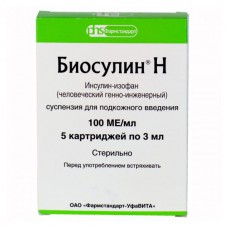Expiration date: 07/2026
The composition and form of issue:
Solution for injection. 1 ml contains:
insulin soluble (human genetically engineered) 100 IU
excipients: glycerol metacresol water for injections
in vials of 10 ml in a cardboard pack 1 bottle or cartridges of 3 ml, in a contour acheikova package 5 PCs. in cardboard pack 1 pack.
Description pharmaceutical form:
Colorless or almost colorless, transparent liquid.
Feature:
The short-acting insulin.
Pharmacokinetics:
Suction
The fullness of the suction and the beginning of the effect of insulin depends on the method of administration (p/C or V/m) and the site of injection (abdomen, thigh, buttocks), dose (amount of insulin), insulin concentrations of the drug.
Distribution
Unevenly distributed in the tissues. Does not cross the placental barrier and is excreted in breast milk.
Metabolism
It destroyed insulinase mainly in the liver and kidneys.
Excretion
T1/2 — a few minutes. Urine — 30-80%.
Description pharmacological action:
Is a human insulin produced using recombinant DNA technology.
Interacts with the specific receptor zitoplazmaticescoy external cell membrane of cells to form insulin-receptor complex stimulates intracellular processes, including synthesis of several key enzymes (geksokinazoj, pyruvate kinase, glikogensintetaza). The decrease in the content glucose in the blood due to its increase of intracellular transport, increased absorption and assimilation tissue, stimulation of lipogenesis, glikogenogeneza, a decrease in the rate of glucose production by the liver.
The duration of action of insulin preparations is mainly due to the rate of absorption, which depends on several factors (e.g. dose, method and place of introduction), in connection with which the action profile of insulin is subject to considerable fluctuations, as different people, and at one and the same person.
After p/to the introduction of the beginning of action of the drug observed in approximately 30 min, the maximum effect between 2 and 4 h duration of action 6-8 hours
Indications:
- diabetes mellitus type 1 (insulin dependent)
- diabetes mellitus type 2 (insulin-independent): stage of resistance to oral hypoglycemic, partial resistance to these drugs (in combination therapy), intercurrent disease
- urgent conditions in patients with diabetes mellitus, accompanied by decompensation of carbohydrate metabolism.
Contraindications:
- increased individual sensitivity to insulin or other components of the drug
- hypoglycemia.
Application of pregnancy and breast-feeding:
Data on the use of drugs during pregnancy and lactation is not provided.
Side effects:
From the metabolism: hypoglycemic state (paleness, increased sweating, palpitations, tremor, hunger, excitement, paresthesia in the mouth area, headache). Severe hypoglycemia may lead to the development of hypoglycemic coma.
Local reactions: hyperemia, swelling and itching at the injection site, with prolonged use — lipodystrophy at the injection site.
Allergic reactions: rarely — skin rash, angioedema in rare cases — anaphylactic shock.
Other: swelling, passing of refraction (usually at the beginning of therapy).
Drug interactions:
There are a number of drugs that affect insulin requirements.
Hypoglycemic effect of insulin increase the oral hypoglycemic drugs, MAO inhibitors, ACE inhibitors, carbonic anhydrase inhibitors, nonselective beta-blockers, bromocriptine, octreotide, sulfonamides, anabolic steroids, tetracyclines, clofibrate, ketoconazole, mebendazole, pyridoxine, cyclophosphamide, fenfluramine, lithium preparations preparations containing ethanol.
Hypoglycemic effect of insulin to weaken oral contraceptives, corticosteroids, tireoidnye hormones, tiazidnye dioretiki, heparin, tricyclic antidepressants, sympathomimetics, danazol, clonidine, CCB, diazoxide, morphine, phenytoin, nicotine.
Under the influence of rezerpina and salicylates may as weakening, and strengthening actions of the drug.
Method of application and dose:
P/to, in/m,/in, 30 minutes before a meal or snack containing carbohydrates.
The dose is determined individually in each case based on the level of glucose in the blood.
The average daily dose of 0.5 to 1 IU/kg of body weight (depending on the individual patient and the level of glucose in the blood).
Temperature of insulin must correspond to room.
Monotherapy multiplicity of 3 times a day (if necessary — 5-6 times a day). When the daily dose exceeds 0.6 IU/kg, should be administered in the form of 2 or more injections in different areas of the body.
Biosulin R usually enter n/a in the anterior abdominal wall. Injection can be made also in the thigh, buttocks or the deltoid region of the shoulder. It is necessary to change the injection site within the anatomical region to prevent the development of lipodystrophy.
The/m and/in Biosulin R you can only enter under the supervision of a physician.
Biosulin R — short-acting insulin and is typically used in combination with insulin average duration of action (Biosulin N).
The injection technique with the use of insulin in vials
If the patient uses only one type of insulin
1. Disinfect the rubber membrane on the bottle.
2. To dial into the syringe, the air in the amount corresponding to the required dose of insulin. To introduce air into the vial of insulin.
3. Turn the bottle with the syringe upside down and dial the desired dose of insulin into the syringe. Remove the needle from the vial and remove air from the syringe. To verify the correctness of the set dose of insulin.
4. Immediately make an injection.
If the patient needs to mix two types of insulin
1. Disinfect the rubber membrane on the vials.
2. Directly in front of the set to roll the vial of long-acting insulin ("cloudy") between your palms until until insulin does not become uniformly white and cloudy.
3. To dial into the syringe, the air in the amount corresponding to a dose of "cloudy" insulin. To introduce air into the vial with "muddy" insulin and remove the needle from the vial ("cloudy" insulin at this stage is not to be gaining).
4. To dial into the syringe, the air in the amount corresponding to the dose of short-acting insulin ("clear"). To introduce air into the vial with "transparent" insulin. Turn the bottle with the syringe upside down and dial the correct dose "transparent" insulin. Remove the needle and remove the air from the syringe. Check the correct dose dialed.
5. Insert the needle into the vial with "muddy" insulin, turn the bottle with the syringe upside down and dial the desired dose of insulin. To remove air from the syringe and checking the dose correctly typed. Immediately to inject insulin mixture typed.
6. To gain insulin should always be in the same sequence described above.
The injection technique when using insulin cartridges
The cartridge with the drug Biosulin R is designed for use only with syringe pen Biosulin Pen. Patients should be cautioned to carefully follow the instructions in the instructions for use syringe-pens for insulin.
Before use, ensure that the cartridge with the drug Biosulin R there is no damage (e.g. cracks). Do not use the cartridge if there is any visible damage. After the cartridge is inserted into the pen through the window of the cartridge holder needs to be visible colored stripe.
After injection, the needle should remain under the skin for at least 6 s. keep the button pressed until the complete withdrawal of the needle from the skin, thus proper dosing and to limit the possibility of contact with blood or lymph in the needle or cartridge with insulin.
The cartridge with the drug Biosulin R is intended for individual use only and may not be re-filling.
Injection procedure
1. Two fingers should gather a fold of skin, then insert the needle into the base of the fold at an angle of about 45° and introduce insulin into the skin.
2. After injection, the needle should remain under the skin for at least 6, in order to ensure that the insulin completely.
3. If after removing the needle at the injection site appears blood, you must press the injection site with your finger.
4. Should change seats injections.
Overdose:
Symptoms: may develop hypoglycemia.
Treatment: mild hypoglycemia, the patient can remove the, taking into sugar or carbohydrate-rich foods. Therefore, patients with diabetes should always carry sugar, sweet fruit juice or other sweets.
In severe cases, the loss of patient consciousness/injected a 40% solution dekstrozy in/m, p/K, V/ — glucagon. After recovering consciousness, the patient is recommended to take food rich in carbohydrates, to prevent recurrence of hypoglycemia.
Special instructions:
You cannot use Biosulin R, if the solution is cloudy, discolored, or solid particles are detected.
On the background of insulin therapy is necessary to constantly monitor the level of glucose in the blood.
Causes of hypoglycemia in addition to insulin overdose may be: the replacement drug, skipping meals, vomiting, diarrhea, increased physical activity, diseases, lowering the need for insulin (liver and kidneys, adrenal, pituitary or thyroid glands), changing the injection site, as well as interaction with other drugs.
Incorrect dosage regimen or interruptions in insulin delivery, especially in patients with diabetes mellitus type 1 can lead to hyperglycemia. Usually the first symptoms of hyperglycaemia develop gradually over several hours or days (appearance of thirst, frequent urination, nausea, vomiting, dizziness, redness and dryness of the skin, dry mouth, loss of appetite, the smell of acetone in exhaled air). If not treated, hyperglycemia in diabetes mellitus type 1 can lead to the development of life-threatening diabetic ketoacidosis.
The dose should be adjusted when significant physical exertion, infectious diseases, fever, disorders of thyroid function, Addison's disease, hypopituitarism, liver and/or kidneys, diabetes in persons over 65 years, increase in the intensity of physical activity or change in the usual diet.
Concomitant diseases (especially infectious) and state accompanied by fever, increase the need for insulin.
The transition from one type of insulin to another should be under the control of level of glucose in the blood.
The drug reduces tolerance to alcohol.
In connection with the possibility of some precipitation catheters is not recommended to use the drug in insulin pumps.
Effects on ability to drive vehicles and management mechanisms
In connection with the primary purpose of insulin by changing his appearance, or when a significant physical or mental stress impacts on the body may reduce the ability to drive a car or to control various mechanisms and other potentially hazardous activities, require increased attention and psychomotor speed reactions.
Expiration date:
After opening the bottles - 6 weeks, cartridges - 4 weeks at a temperature of 15-25 °C.


